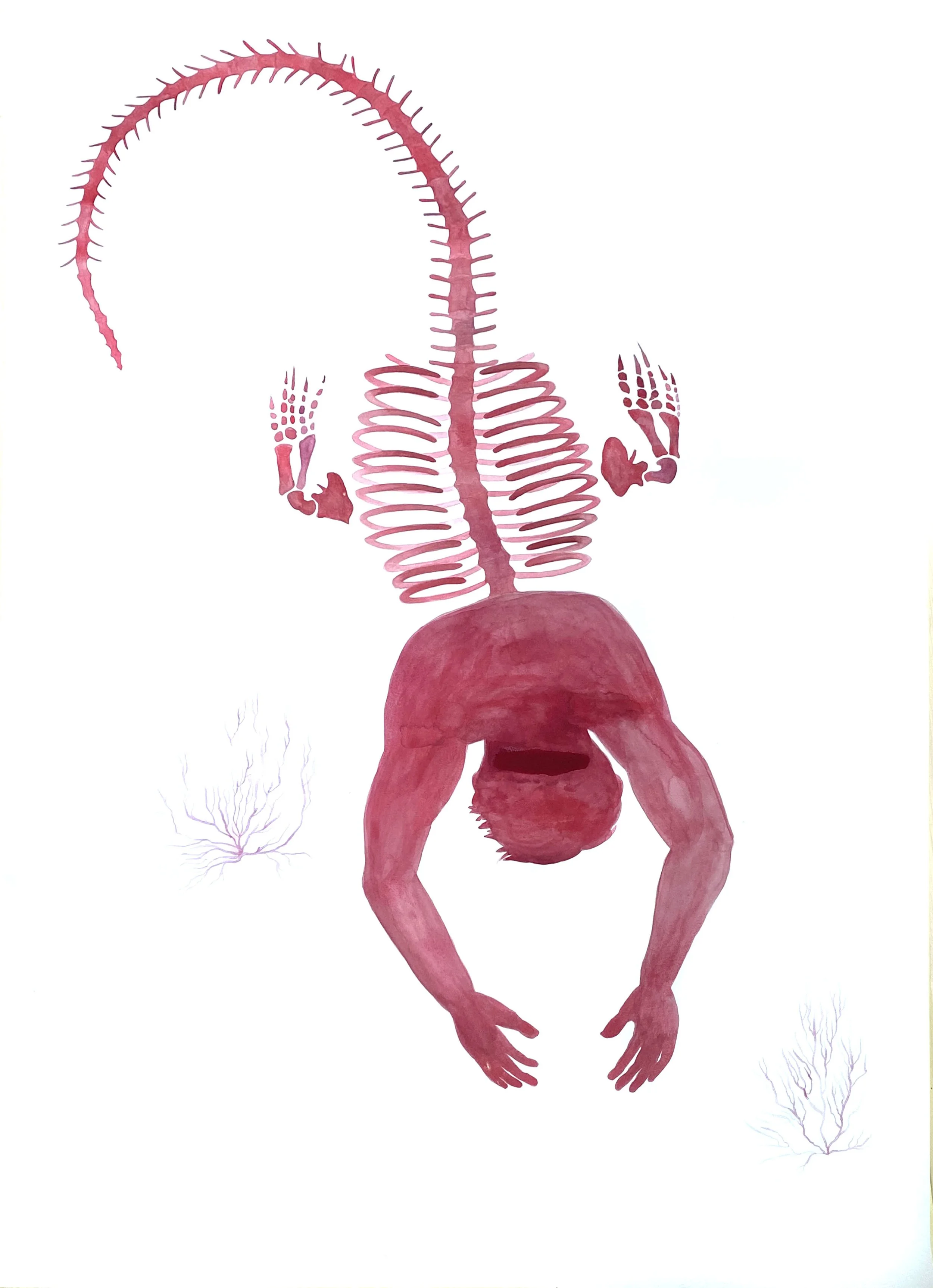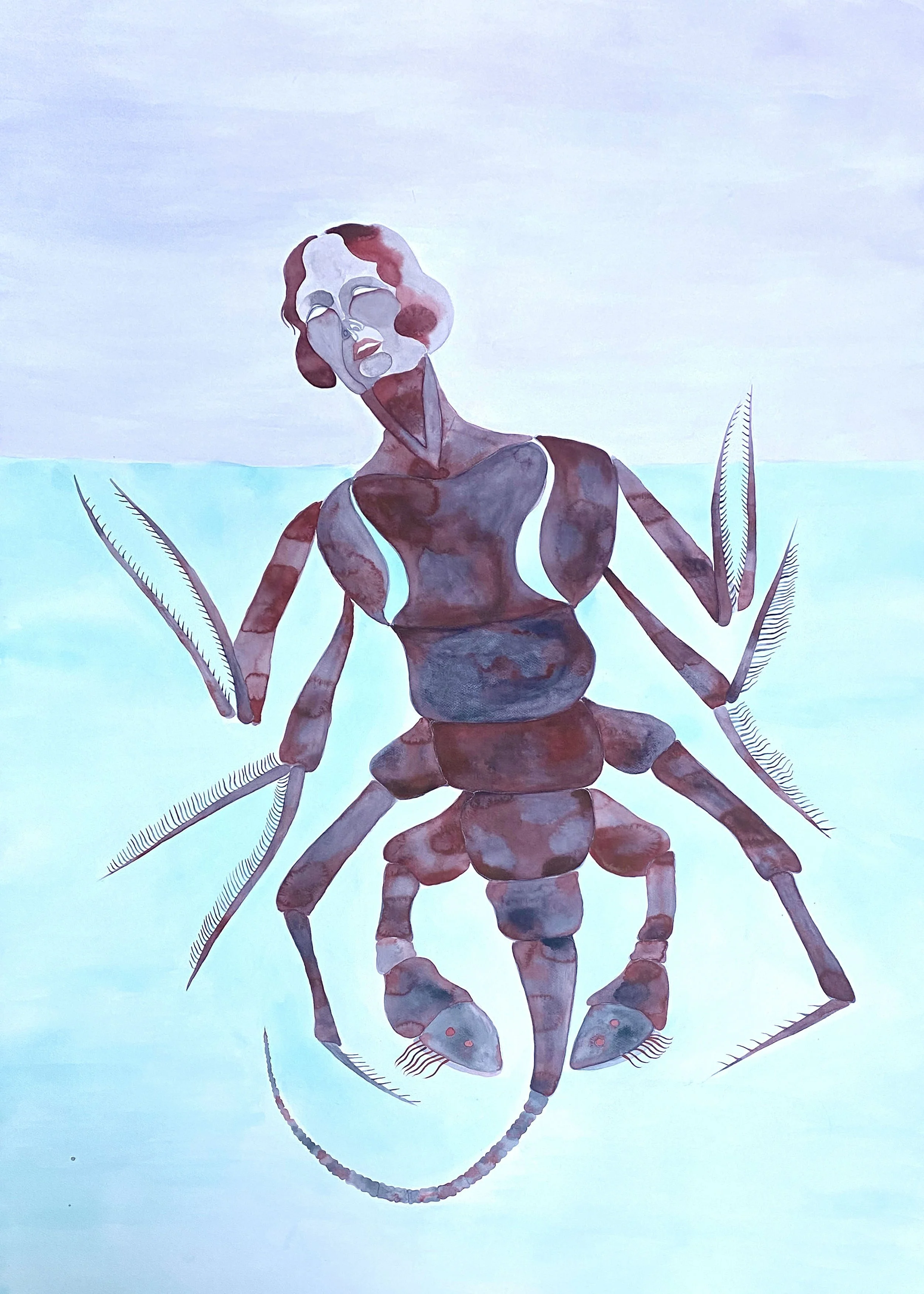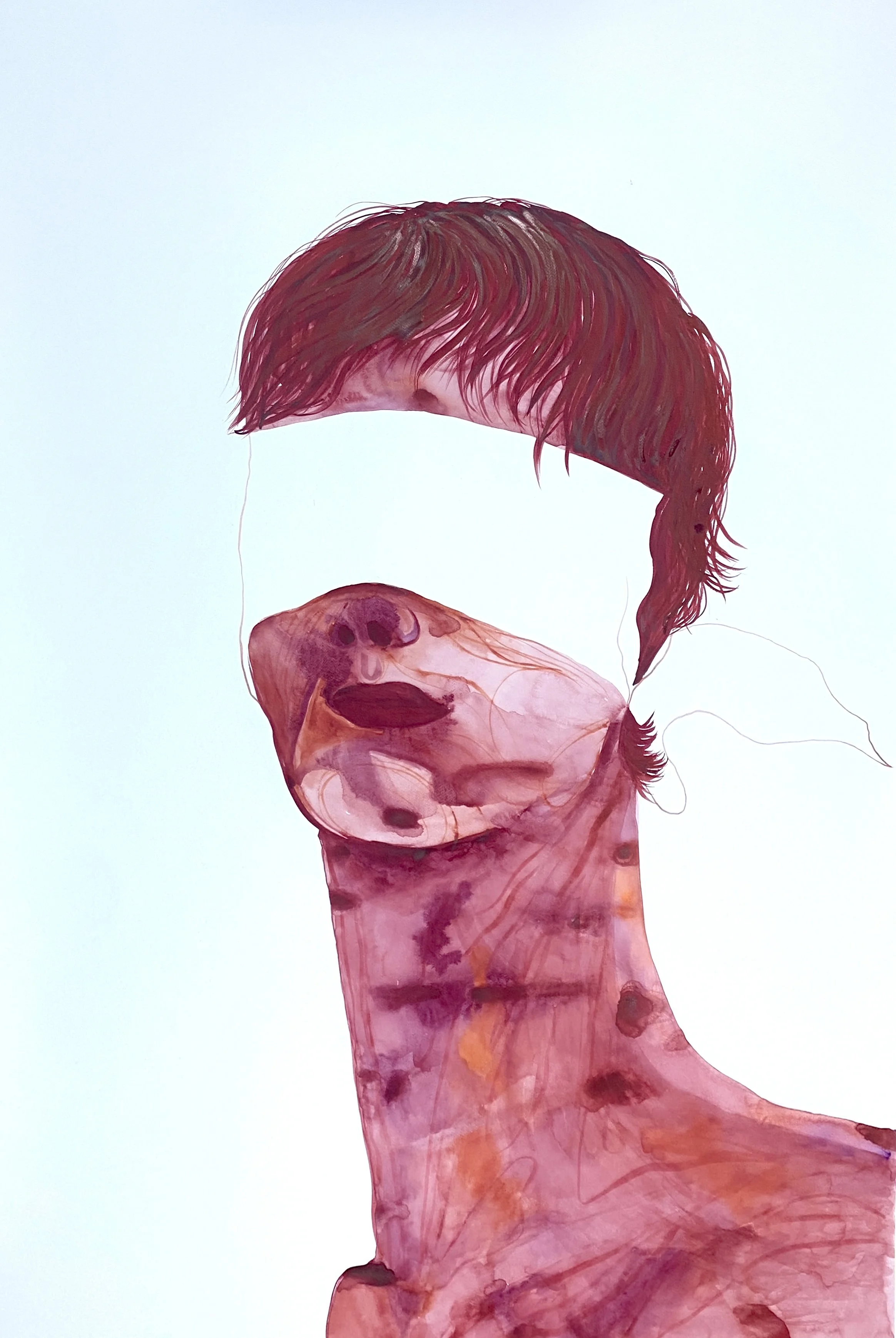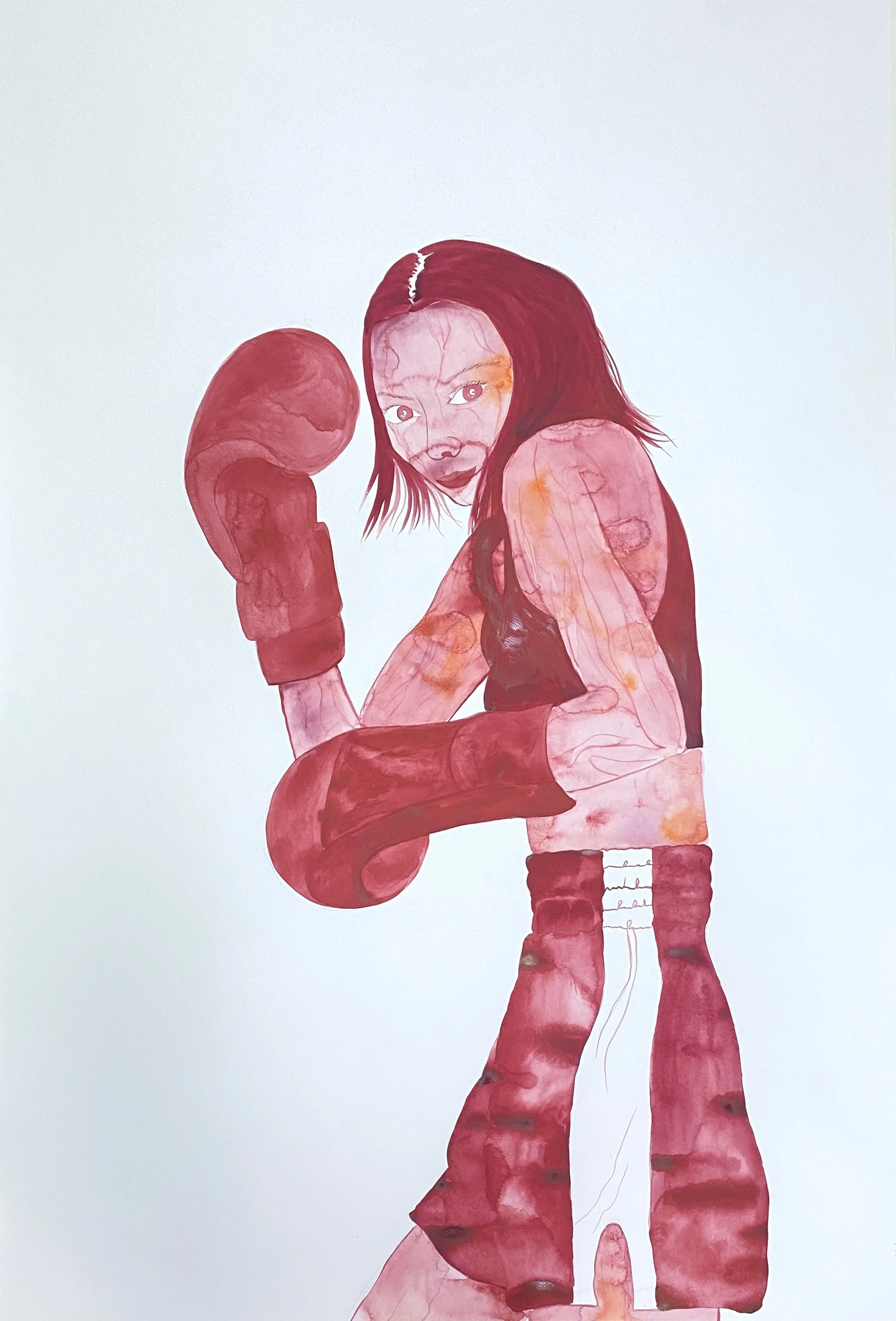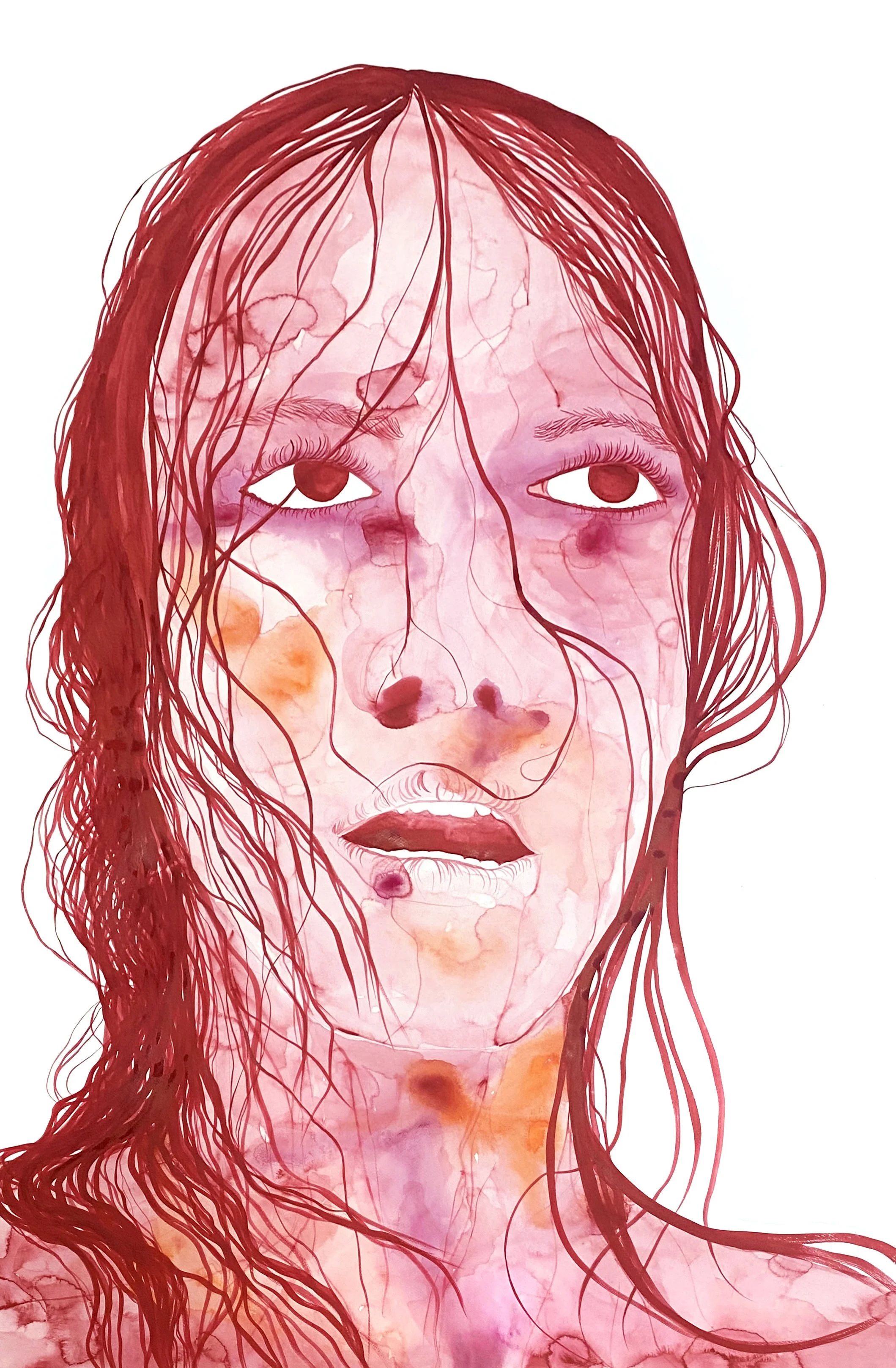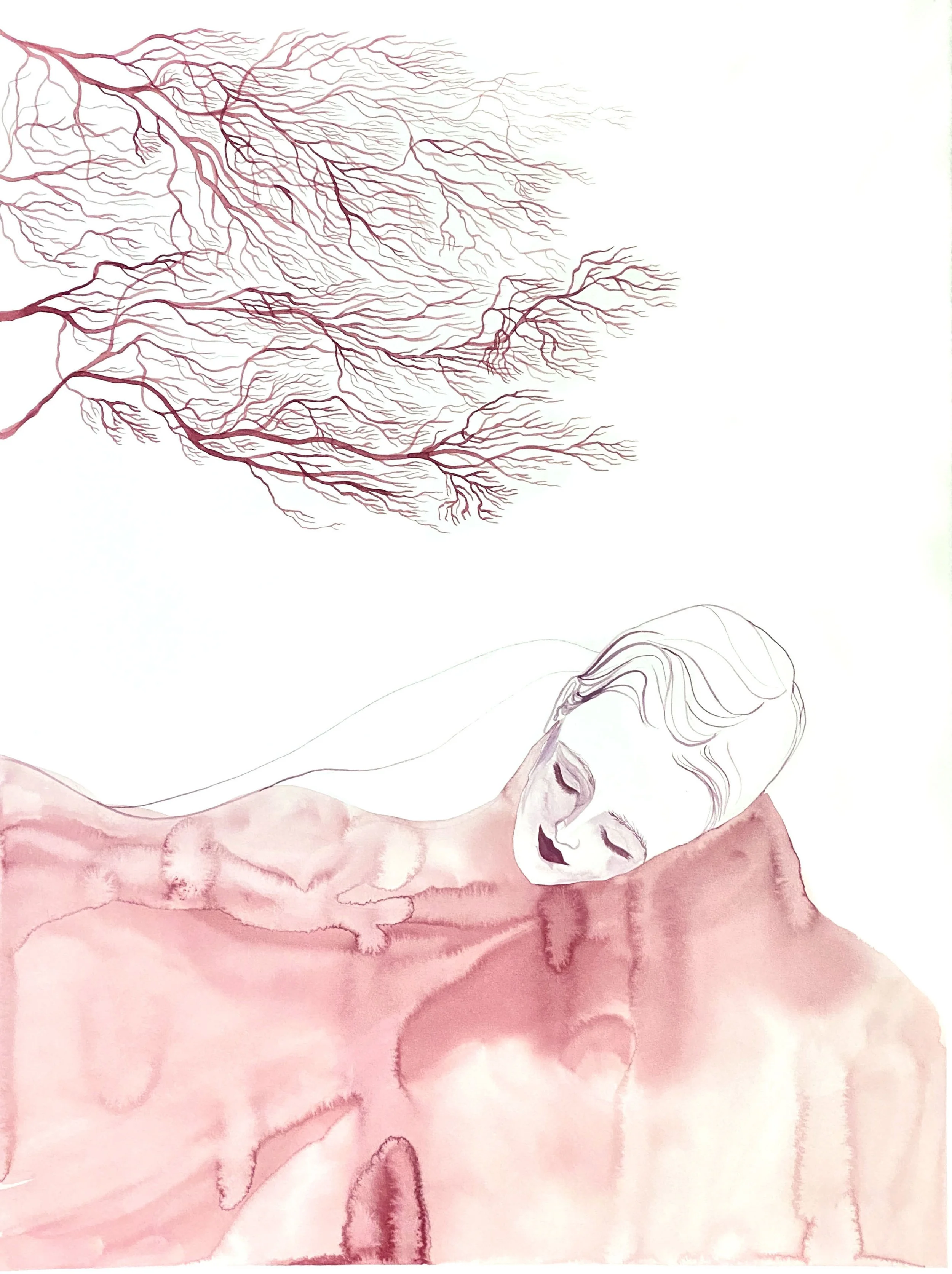Mar Adentro
Nereus, watercolor and acrylic ink on paper, 2025
150 x 100 x 1 cm | 59.06 x 39.37 x 0.39 in - more details here
Mar Adentro explores, through contemporary drawing techniques, the climate crisis and the fragile disappearance of aquatic biodiversity. This body of work unfolds as a visual meditation on the ecological transformations of the marine world, adopting a poetic and melancholic aesthetic. The works trace an imaginary cartography of an ever-changing landscape – a liquid and unstable universe where the boundaries between myth and reality blur, and the visible and invisible meet in a continuous flow.
At the heart of this exploration, water becomes both matter, memory, and metaphor. It is at once a nourishing fluid and a destructive force, a memory of life and a graveyard of extinct species. In this universe, the sea is perceived as a liminal space – a bridge between past and future, between legend and disappearance, between beauty and loss.
Populated by mythological figures from various cultures, this drawn universe constantly slips between the collective imaginary and the urgencies of the present.
Through these figures, Mar Adentro proposes a reflection on the way humanity projects its own myths, fears, and hopes onto nature. Drawing becomes here an act of poetic resistance – a tool for reconfiguring the visible, for mourning what is being lost, but also for bringing forth other possible forms of life, between memory and imagination.
In essence, the project offers itself as a visual elegy, a funeral song dedicated to the underwater world that is slowly disappearing before our eyes. But it is also an attempt to weave connections between science and myth, between emotion and knowledge, between the anxiety of the present and the regenerative power of art.
Ran, watercolor and acrylic ink on cotton paper, 2025
76 x 56 x 1 cm | 29.92 x 22.05 x 0.39 in - more details here
Inspired by Norse mythology, this work embodies Rán, the goddess and personification of the sea. Wife of the giant Ægir and mother of the nine wave-daughters, Rán drifts between dream and abyss, silent and mysterious, cloaked in the foam of the waves.
She is depicted with a delicate yet menacing net — a symbol of the sea’s unseen force that draws sailors into the depths. Her net is not merely an object, but an extension of the ocean’s will — a coral, a call toward the unknown, toward the beauty and danger hidden beneath the water’s surface.
The piece combines the fluid transparencies of watercolor with intense accents of acrylic ink, capturing the contrast between the sea’s visual allure and its unforgiving power.
This composition evokes myth as an echo of a lost world, where deities dwell not in the heavens, but within the waves.
Vaquita, watercolor and acrylic ink on paper, 2025
65 x 50 x 1 cm | 25.59 x 19.69 x 0.39 in - more details here
This watercolor and acrylic ink painting on paper presents the delicate and haunting image of a vaquita skeleton—an homage to one of the most endangered marine mammals on Earth. Rendered in soft, muted washes of red and sepia tones, the skeleton floats in an abstract, dreamlike space, suspended as if drifting through water or memory.
The bones are painted with fine, almost reverent attention to detail, their gentle curvature suggesting both the elegance and fragility of the vaquita’s small form. The skull, with its distinctive proportions, tilts slightly as if still listening to a distant current, while the ribcage expands like the delicate frame of a lost breath. Watercolor blooms spread across the paper like currents or sonar echoes, subtly blurring the boundaries between body and sea.
Camenae, watercolor and acrylic ink on paper, 2025
150 x 100 x 1 cm | 59.06 x 39.37 x 0.39 in - more details here
The Camenae are a group of prophetic water Goddesses or nymphs of ancient Rome, considered Goddesses of poetry as well as birth Goddesses who presided over springs and were invoked for healing. Their name is related to the Latin word carmen, meaning "charm, song, poem, magical formula, or prayer".
Charybdis, watercolor and acrylic ink on paper, 2025
150 x 100 x 1 cm | 59.06 x 39.37 x 0.39 in - more details here
This watercolor and acrylic ink drawing on paper presents a striking hybrid creature—an imaginative fusion between Dulcibella camanchaca, a deep-sea amphipod known for its resilience, and Charybdis, the fearsome sea monster of Greek mythology.
Rendered in fluid, layered washes and fine ink detailing, the creature embodies both survival and destruction, reflecting the duality of nature in the face of environmental upheaval. The translucent, almost ghostly exoskeleton of the amphipod merges with the swirling, vortex-like body of Charybdis, forming a being that is at once delicate and terrifying.
This hybrid serves as a metaphor for the Anthropocene’s contradictions: the ability of life to adapt and persist, entwined with the looming forces of ecological imbalance and mythic-scale collapse. It invites contemplation on evolution, fear, and the fragile boundaries between mythology and modern environmental realities.
Hoori, watercolor and acrylic ink on paper, 2025
150 x 100 x 1 cm | 59.06 x 39.37 x 0.39 in - more details here
In this watercolor, I veil Hoori’s eyes with the white ribbon of the vow he broke—the promise not to look upon his wife as she gave birth. A myth about love, disobedience, and consequence, but also about the ancient policing of female bodies and the male gaze.
What does it mean when trust is conditional and curiosity punished?
Aphrodite, watercolor and acrylic ink on paper, 2025
150 x 100 x 1 cm | 59.06 x 39.37 x 0.39 in - more details here
They called her the goddess of love and beauty — but in Cyprus and Sparta, Aphrodite was also a warrior. This watercolor is my vision of her: not just the muse, but the force. A woman in the ring. Strong, sensual, sovereign. Because femininity isn't fragile — it's fierce, layered, and unafraid to fight for itself. For all of us who’ve lived, endured, risen — this is our Aphrodite. Not just adored. Respected.
Asiaq, watercolor on paper, 2025
150 x 100 x 1 cm | 59.06 x 39.37 x 0.39 in - more details here
Asiaq, the Inuit goddess of weather — rendered in water, her image is blurred like coastal ecosystems in flux. This piece is part of my series on climate change and marine biodiversity loss in the Anthropocene: a visual exploration of how cultural and ecological systems erode under pressure.
Tlaloc, watercolor and acrylic ink on paper, 2025
76 x 56 x 1 cm | 29.92 x 22.05 x 0.39 in - more details here
This watercolor and acrylic ink drawing on paper presents a haunting and symbolic depiction of Tlaloc, the Aztec god of rain, water, and fertility, reimagined through a composition of two intertwined sea serpent skeletons encircling a fragile coral structure.
The serpents—skeletal and sinuous—form a protective yet tension-filled spiral around the central coral, their ribs arching like waves frozen in time. Painted in translucent, bone-like tones with delicate ink linework, their forms evoke both movement and decay, suggesting the lingering force of ancient waters now stilled or desiccated.
Though Tlaloc is not depicted directly, his presence permeates the image. The creatures’ skeletons reference his association with water serpents and the cyclical violence of rainstorms and droughts.
Doris, watercolor and acrylic ink on paper, 2025
76 x 56 x 1 cm | 29.92 x 22.05 x 0.39 in - more details here
This work brings to the forefront Doris, a sea nymph from Greek mythology, one of the three thousand Oceanids and daughter of the Titans Oceanus and Tethys — primordial deities of the waters. Doris is best known as the wife of Nereus, the “Old Man of the Sea,” and the mother of the fifty marine nymphs known as the Nereids, spirits of calm seas and protectors of sailors. In ancient art, Doris sometimes appears alongside her husband or daughters, but she is rarely easy to recognize, often depicted as a generic goddess — beautiful and draped in a flowing mantle. In this interpretation, her image is reimagined through aquatic textures and subtle contours, suggesting her diaphanous and archetypal presence in the marine universe. This piece is a tribute to a lesser-known yet essential figure in the genealogy of Greek sea deities — a discreet goddess, deeply connected to the beginnings.
Chaac, watercolor and acrylic ink on paper, 2025
76 x 56 x 1 cm | 29.92 x 22.05 x 0.39 in - more details here
In this vibrant composition created with watercolor and acrylic ink, the Maya rain god, Chaac, comes to life in a symbolic vision charged with mythological power. Frogs were considered sacred beings associated with the arrival of rain. For the Maya, the frogs’ song, especially during the rainy season, announced the approaching storms—and, by extension, the presence of Chaac, the god of thunder and rain. In some ceramic depictions, Chaac is accompanied by amphibians. Around him flow waves of watercolor in subtle shades of violet and red, evoking both the fertility brought by rain and the destructive force of storms. The artwork conveys both ancestral respect for the powers of nature and fascination with the mysteries of the sky and rain.

